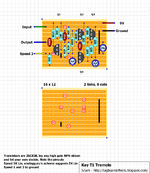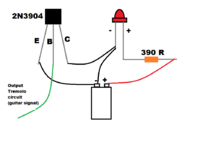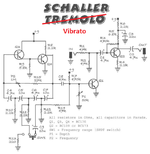bzblues
Full Member level 1
Hi everyone! hope you are good!
I have a question. I've built this tremolo effect guitar pedal and I was thinking ono addin and LED that reacts to the tremolo signal (blinking on and off). Now, the thing is that I linked the circuit to a guitar amplifier, so it's like a built in guitar amp with tremolo effect. I did my research on how to add an LED to a sound signal, by adding a 2N3904 transistor with a 390 ohm resistor to but In the end I would start blinking with or without the tremolo effect, just would react to the guitar signal, so the logical thing to do (at least for me) is to hook it up with the OUTPUT of the tremolo circuit. I tried that but nothing happened. I'll attach the Tremolo circuit and the LED circuit for you to see if I did something wrong.
Thanks in advance for the help!
Cheers!
Brian.
I have a question. I've built this tremolo effect guitar pedal and I was thinking ono addin and LED that reacts to the tremolo signal (blinking on and off). Now, the thing is that I linked the circuit to a guitar amplifier, so it's like a built in guitar amp with tremolo effect. I did my research on how to add an LED to a sound signal, by adding a 2N3904 transistor with a 390 ohm resistor to but In the end I would start blinking with or without the tremolo effect, just would react to the guitar signal, so the logical thing to do (at least for me) is to hook it up with the OUTPUT of the tremolo circuit. I tried that but nothing happened. I'll attach the Tremolo circuit and the LED circuit for you to see if I did something wrong.
Thanks in advance for the help!
Cheers!
Brian.



